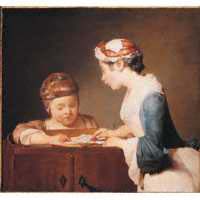To mark the end of the summer holidays and the start of the new school year, this week’s choice of picture is The Little Schoolmistress, by Jean-Simeon Chardin. The work was painted in around 1735-6 and can be found at the National Gallery. It is one of the most beautiful examples of Chardin’s gentle and profoundly humane art.
The subject is in fact a private lesson, being given by a young lady to her much younger sister. With a long metal pointer, the “little schoolmistress” of Chardin’s title indicates one of the letters of the alphabet printed in the pages of the book that lies open before her. The oblique angle at which the painter has placed her head creates the effect almost of a profil perdu (or “lost profile”) and accentuates the pursing of her lips. This could just be a sign of concentration, but I suspect that the painter meant us to understand that she is teaching her lesson phonetically, enunciating the sound signified by the letter to which she points – which might, perhaps, be an “e”. The smaller child attempts to follow, reaching forward to point with her own chubby finger and perhaps beginning to shape her own lips to make the same sound as her sister. The piece of furniture on which they are both leaning seems to be part folding table, part cabinet. Light gleams on the dark metal of the key in its lock, which projects towards the viewer from the shallow space inhabited by the characters in the scene as if gently to point a meaning. A store of learning is being opened to the little girl.
Chardin’s paintings were almost unique in the France of his time in that they cut across class, pleasing both the rich, who bought them,...


